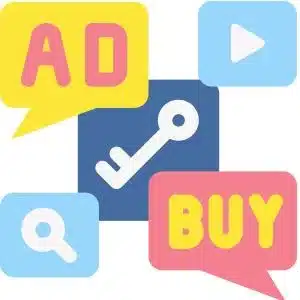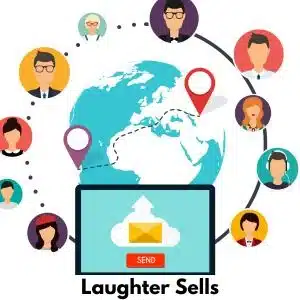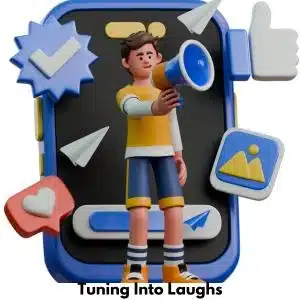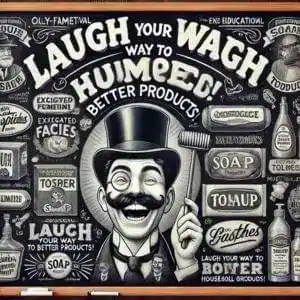Start of humor in ads was a magical touch to advertisement industry. Imagine a vision of fresh green leaves moving from side to side under the warm sun. It was light, simple, and full of energy. Before this , it was tricky, like a kitten chasing a string. But now, it has grown a lot. From simple funny jokes to sharp, clever parody, humor in advertising has come a long way up till now.
In this article we will explore and discuss each and every minute aspect of how it evolved. It’s like a mirror to society which reflect trends, cultural values, and fun. It always keeping us laughing, giggling, or maybe even busting a laughter. Humor in ads is not just about laughs, it is also about connecting peoples. Sit comfortably and jump into this article as it is mix of fun and history with a fun of uncertainty.

1. The Birth of Humor in Advertising
Laughter Sells
Back in the history, when the scent of fresh ink was very popular at a particular time, print ads started to touch humor . In 1800s, early 1900s funny headlines and tricky taglines were just started to appear. Initially these did not contain a powerful and impactful moments. It was Reserved and Classy and strangely engaging.
Early ads were all about wordplay with clever bits and pieces that made you laugh, and that was smart. They sold household gadgets with stories of picture perfect home life, showered with a little mischievous exaggeration. The jokes were full of clever literary references oriented towards book lovers.
In early twenties a boom of humor in advertisement came out the window. Humor got adventurous, wilder like it had too much fun at a secret party. The funny stuff started to run the show. Now to Focus on sustainability had little priority.
2. The role of humor in advertising
The core purpose of humor in advertising is all about using comedy and sarcasm in a way that people get interested in what you are selling. It is a best way to connect with your audience and most importantly making your brand feel more relatable, shareable, and fun. The question arises why it does work so well? The answer consist of many aspects like
A. People laughing:
It makes people laugh. Humor in advertising means using funny but creative content to make ads more entertaining and important.
B. Makes your brand stand out
Humor is the easiest yet important way to help and grab attention. Many people automatically tune ads out, either online banner ads or TV commercials. But you know a funny ad can break through apathy, and encourage people to take notice of your brand and its offerings.
C. Creates a positive emotional connection
Funny and interesting ads also make people feel good and engaged. Laughing releases endorphins, boosting positive emotions and creating a pleasant association with your brand. This makes people more likely to remember your ads and develop an emotional connection with your company. This is the core secret for effective brand building and customer loyalty.
D. Increases the chances of going viral
Another big plus of humor is that it encourages sharing. Just think about how often you’ve shared a funny video or meme with friends. If your ad is humorous, people are more likely to share it widely on social media platforms. Such user-generated content helps your message spread without any extra cost or effort from you.
3. How humorous ads can go wrong
Humorous ads helps to grab attention and engage audiences in brilliant ways and distinguish from other ads. But trying to be funny can sometimes go wrong and cause problems for your brand. Here are some important points to consider.
A. Humor potentially being taken the wrong way
Humor in ads can easily be taken in wrong way. This can be dangerous and risky. Humor is highly personal, and depends on their culture, social background, and personal taste. Sometimes, a cheerful and happy joke might not get the laughs you hoped for or could give offence to some people. This could damage your brand’s image, integrity and distance parts of your audience.
B. Risk of detracting from what you’re advertising
Their is a risk that the comedy will distract your target audience from the product or service you are trying to sell. The main aspect of your ad is to get people interest in what you are offering. Humor must be to enhance your message, not to attract the most of the attention.
C. Possibility of a short-lived marketing impact
A funny ad might get lot of attention in rapid time, but that consideration can annihilate quickly. And we know once the novelty wears off, people might forget about your ad. This usually happen when some brands focus too much on humor alone, which results in the comedy conceal your marketing message.
2. The Radio Era: Tuning Into Laughs
In the early dominants 1920s and crowded 1930s, humor in advertising sizzled its way into homes like a warm and pleasant breeze. No one have thought radios could become the megaphones of laughter? Radio ads were not just about giving information but they were also made to entertain in parallel world. Suddenly at once, sales tones came with eye catching songs and with funny characters that could bring around even the biggest doubters.

Renowned celebrities’ like Jack Benny and Bob Hope through their comedic talents played a key role in transforming boring advertisements into eye catching and engaging content. Their genius brought a sense of humor and zeal, offering moments of cheerfulness even during the challenging times of the Great Depression. They managed to make daily using products like toothpaste or soap appear unexpectedly entertaining by adding simple jokes based humor. In this special way, radio served us an early form of consistent entertainment which was trustful and easily accessible to audiences.
This humor accompanied approach cleverly engaged audiences while delicately showcasing the product, making it an innovative and much effective strategy.
3. The Golden Age of Television: From Jingles To Gossips
With the passage of time world has moved towards modernity, the 1950s gave us television which proved to be a gamechanger in how humor sold products. Before this carbon footprint gossip took center stage. Suddenly, ads become tactful, colorful, vibrant, and downright entertaining. Imagine funny slogans for bubbly detergents or animated mascots bouncing around. This was the perfect mixture of storytelling and tactful humor at its peak!
Lucille Ball’s iconic Vitameatavegamin routine was a core example of using comedy and fun to promote products successfully. Most memorable slogans like Maxwell House’s “Good to the last drop” became famously recognized during this time, directed by creative visuals and engaging audio. Moreover, many celebrity sung funny jingles which was mixture of music and marketing, leaving a ever lasting impression on audiences and making advertisements more impactful and memorable.
When people were not really talking about sustainability, this era set the stage for how humor could coordinate with marketing to leave an unforgettable impression. yet, but the seeds were being planted.
4. The New Millennium: From Billboards to Smartphones
As far as the digital age begin, humor in advertising became pocket sized and quite completely. It is like changing old school typewriters for modern tablets. Zero waste is not just about recycling, it is all about reusing creativity across each and every digital platform you can think of about in the world.
Brands targeted younger audiences scroll on platforms like YouTube by viral marketing, creating funny jokes and funny clips. Funny memes, funny tweets, and responsive moments became new approach to grab attention, thanks to how quickly social media spreads things. Remember of Bud Light’s “Dilly Dilly” or Pharrell’s catchy “Happy”? These were not mere ads, they became part of everyday culture afterward.
By skillfully composting old ideas, upcoming brands kept their ignite alive while chasing the undistracted vision of a happy audience.

5. The Present Vision: Present-Day Punchlines
In today’s meme-driven world, humor in advertising is sharper, cooler, and, honestly, a bit snarky. Think of creative humor as the organic farming of ads – fresh, real, and with a lot of potential for growth!
Brands are finding clever ways to mix wit with environmental messaging, making people laugh while promoting eco-friendly choices. It’s like planting little seeds of awareness and seeing them grow in the digital space. Influencers have become the new faces of green energy – and they’re doing it with a dose of charm, helping spread the word on solar power, sustainability, and reducing your carbon footprint.
A few stories along the way? Oh, we’ve got them.
Imagine wind-powered characters, bringing green energy into the spotlight with humor that’s as breezy as a spring day. Or the satirical Mann vs Wild-style ads where actors tackle city life with eco-friendly products. Ads have come a long way from catchy jingles; now they’re sneaking in jokes and whispering sustainability in ways that make us smile and think at the same time.
6. A Legacy of Laughter: The Evolution of Humor in Advertising
Humor’s journey in advertising? It’s more than a tale. It’s an eco-friendly saga of growth, adaptation, and transformation, kind of like a carnival ride that never ends. It’s naturally embedded in the green building mindset, always evolving.
Brands are planting seeds in a sustainable way, using humor as a “tool” to push eco-awareness and reduce pollution. Like nature’s cycles, funny ads get recycled, reused, and upcycled—turning clever moments into something with a longer life span.
In today’s world, where confusion sometimes reigns, humor in advertising thrives. It’s proof that sustainable development goals (SDGs) aren’t just for meetings and documents—they belong in your feed, in funny ads you can laugh at and learn from.
Advertising humor may have danced through the years, shifting with societal changes, but one thing’s always been constant: its core purpose—to grab attention and get a smile. As we lean into this eco-conscious era, humor continues to mesh with meaningful messages, creating a lasting crop of laughter and impact.
220+ Funny Apple Puns And Jokes: Hilarious Core Laughs

7. Final thoughts:
In conclusion, today use of humor in advertising is right at the crossroads of cleverness and eco-consciousness. It’s like a plant growing in the wild – no rules, just good soil to thrive in. The more we nurture creativity, the more we see how humor can be a powerful tool in the fight for a sustainable future.
Who says you can’t save the planet while cracking jokes? It’s a mix of sunshine, smart ideas, and a whole lot of laughs. Birth of humor in advertising in ads isn’t just a trend – it’s a message wrapped in wit, reminding us to keep laughing, living, and leaving the Earth better than we found it.

Alexander is the founder of Puns Party, a dynamic platform that bridges the gap between information and entertainment. Offering insights into business, technology, fashion, and entertainment while infusing humor, Puns Party delivers content that is both engaging and thought-provoking.

